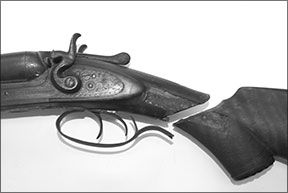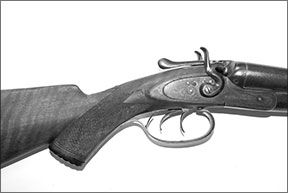How many old stocks have you seen that were broken at the wrist, repaired and then broken again? If you have been around guns for very long I’m sure you have seen your share. Based on the number of badly repaired old stocks that I have worked on, most folks think all it takes is some glue and perhaps a few screws and a splint or two. When the gun breaks in the same place a time or two they give up the job and put stock repair into the black arts file.

Generally, by the time the gun gets to me the owner has given up hope and simply wants to sell the gun. The few that I quote a repair on are generally of sentimental value to the owner and are obscure or rare enough that no replacements stocks are available for them. They come in with wire wrapped around the broken wrist like a cast. Strips of wood or metal inletted across the break and screwed and or glued in place, rawhide wraps, metal bands and sometimes a combination of several of these attempts and there is always evidence of glue—lots and lots of glue. Many of these repairs were brilliantly thought out and expertly executed but still failed and even if they held they were downright ugly.
The reason for the failure is generally simple to detect. Over time the wood has absorbed a lot of oil. Oil originally swabbed into the bore to prevent rust has run down the stock and been soaked up by the wood. Any gun not stored muzzle down is eventually going to have the stock become oil soaked. In a lot of old doubles, the oil itself has been a contributing factor in the stock breaking in the first place. The first lesson in stock repair is that glue, no matter how good, will not stick to oil. So, the first job in repairing a stock is to remove every possible trace of oil from the wood. You may think you already know how to do that. There are plenty of products on the market that are great at removing oil on or near the surface. Oven cleaner, paint stripper and bleach are just a few of those I have used. If you use one of these and glue up the stock, chances are that within a few weeks more oil will migrate to the surface and the joint will eventually fail when the oil soaks into the wood where it is in contact with the glue. If you don’t believe this, next time you have cleaned up an oily stock with oven cleaner try heating the stock over a stove or with a heat gun. I’ll bet you see oil bubbling up to the surface.
Besides being ugly, screws in the stock never seem to help for long. Recoil vibration through the wood loosens them and walnut is soft enough to crack around them. A screw hole is a weak spot. As the screws vibrate and move they leave more damage than you started with. Now that we have looked at what doesn’t work, let’s take a look at something that does. Remove the stock from the gun and take off all butt plates, recoil pads, grip caps, nuts, bolts, nails, rawhide, clamps, plastic model airplane parts or whatever type of old repair material. Now, you may simply have a cracked stock with or without missing pieces of wood or you may have one actually broken in two or more pieces. I can’t anticipate every possible combination of problems so I will simply address wood preparation that will allow an adhesive to work.

Once the stock is off the gun and all we have is the wood, start the enhanced interrogation with what I will call “water boarding.” Scrub the living daylights out of the wooden stock using hot water, soap, and a cleaning brush. Any soap will do and any stiff nylon brush will be just fine. This operation will remove dirt, grease, grime, oil, and any oil-based finish. After giving it a good scrub, rinse it in hot water and dry it off with an old towel. I will often do this several times allowing the stock to air dry between water boarding sessions, concentrating on any areas that are still darker than the others. Usually the end grain and inletting for tangs, trigger plates and sidelocks, if present, require extra attention.
When I am sure I have removed as much dirt and oil as the soap will get, I evaluate the stock. Any darker areas in the inletting, the broken sections, the front where the receiver meets the wood and the end of the butt that was under the buttplate or recoil pad get sprayed with oven cleaner. Let the oven cleaner work for at least twenty minuets, wash it off, let the stock dry, and repeat as often as necessary. If you’re lucky and the gun is fairly new you may be able to stop here. Personally, the guns I get always seem to be older than the dirt I just removed from them.
By this time any pieces of wood that had been glued on should have come loose. Check every surface that was glued and use a dental pick or other sharp pointed thing to probe every nook and cranny and remove every trace of old glue that you can find.
At this point you are probably sure that you have removed every molecule of oil that ever came within ten feet of the stock and you are ready to start putting it back together. Chances are you’re wrong. To check, heat the stock again and I’ll bet you will still have oil coming to the surface. If I am wrong, then you truly lead a charmed life and the gunsmithing gods are smiling on you. Ah, but if ye find that thee are still but a mere mortal and the devil’s petroleum still bubbles forth from yon wood, it’s time to quit fooling around and get serious. Up until now the job has been pretty labor intensive so, lets break out our old witch’s caldron and use a magic potion of our own to do some of the work.

First you’ll need a caldron, or at least a container large enough to submerge your wood in. If you don’t happen to have a bluing tank handy you can look at the home center or nursery for a one piece plastic flower box, a chicken feeder or something similar. Put the wood into the container, weight it down, and fill the container with turpentine until the wood is completely covered. Cover the container because turpentine really stinks and evaporates rapidly. Actually, if you’re married and try this in the house you may find yourself and your project living in your truck. It might be best to do this in a garage or shed. Now walk away for two weeks.
OK, you can’t leave it to just soak without checking on it at all. Every day or two you can remove the cover and scrub the dickens out of it just to see how it is going. The idea is for the turpentine to completely soak into the stock and displace every drop of oil it can. At the end of the two weeks remove the wood, scrub it with soap and hot water again and hang it in the garage or shed to dry for a week. By then most of the turpentine fumes will have dissipated and you will be able to get within three feet of the wood without your eyes watering.
Now, if you’re a wimp, I will mention that I have experimented with odorless mineral spirits once. It seemed to get the same effect with a fraction of the smell but turpentine is less likely to damage the wood. Besides what fun would it be if you didn’t have that terrible smell?
Finally, we come to the actual repair part (had about given up, hadn’t you?). Your main repair materials will be Brownells Acraglas Gel (or any other inferior epoxy of your choice) and Stock Repair Pin Kit (Brownells #080-565-093AD.) In the case of a really difficult repair I have also used a 3/8″ all thread rod cut to length. The trick is to locate the pins or rod in the center of the largest area of the broken stock.
Drill holes that are oversized and deep enough to accept the reinforcing rods and allow enough room to align the stock. Drill the holes, put the pins in them and fit the stock together. Now is the time to find out if you need to make the holes deeper or bigger to properly align the pieces. If there were inletted splints of wood or metal, make strips of matching walnut to fit the inletted areas. Once you are able to put the stock together and get it properly aligned, degrease the holes you drilled with a fast evaporating degreaser like Birchwood Casey Gun Scrubber. Yeah, I know, you just soaked the stock for two weeks to be sure there was no oil in it, so why do you need to degrease it again? Because it takes two seconds and a stitch in time saves nine, there’s no sense closing the barn door after the horse is out, guys that wear belts and suspenders rarely lose their pants and because I said so.

Spread plenty of newspaper around because things are about to get messy. Wear an apron and disposable gloves. Don’t say I didn’t warn you! Mix the Acraglas Gel according to the directions and dye it a few shades darker brown than the stock wood. Using a spoon, tongue depressor, popsicle stick and/or anything else that will get the Acraglas where it needs to go, fill all the holes you drilled and those left by nails or screws and every nook and cranny of both sides of the broken area. Insert the repair pins into the holes you drilled for them. Now join the stock back together displacing the Acraglas Gel and pushing it out every crack, hole and seam and allow it to fill any voids left by missing splinters of wood. In this case, too much is a good thing. You don’t want any voids in the stock.
When you have everything aligned, any pieces put back in place and the walnut strips you made placed into the inletting, clamp the stock together. You can use masking tape, duct tape, latex rubber tubing, rubber bands or whatever. Just remember that once the epoxy sets whatever you used is permanently stuck. I use my mixing sticks to scrape off the wildly excessive epoxy but leave plenty in place so you can sand down to bare wood after it sets. Put the stock aside for 24 hours. Once the Acraglas Gel is set, you can remove any of the excess material, file down and sand to bare wood.
From here, it is simply a refinishing project. Stain the stock to closely match the color of the Acraglas, sand, dewhisker and apply finish. There is no real cure for the nail holes, filled areas or mismatched walnut you used to fill the inletting where the repairs were but checkering will do a pretty good job of hiding them.
What? You say you don’t know how to checker? Well, heck, you didn’t know how to repair an oil soaked stock before now either, did you? Besides you always wanted to try it and now you have a stock to try it on and a reason to learn.































I know someone who needs to have a cracked rifle stock repaired. Do you have a shop? How would he contact you?
Whoever wrote this article is hilarious. It’s rare to read a technical article with this much humor built it.